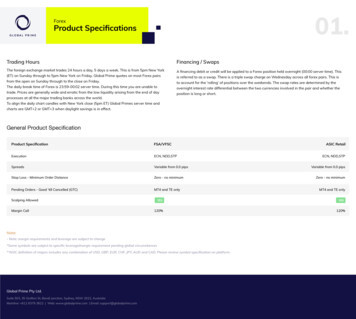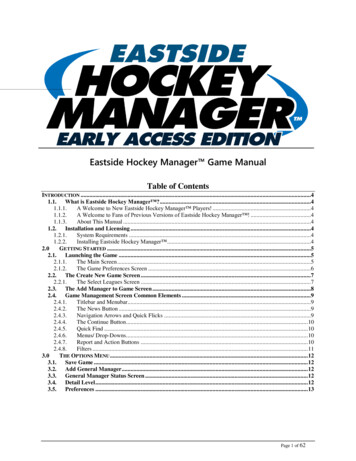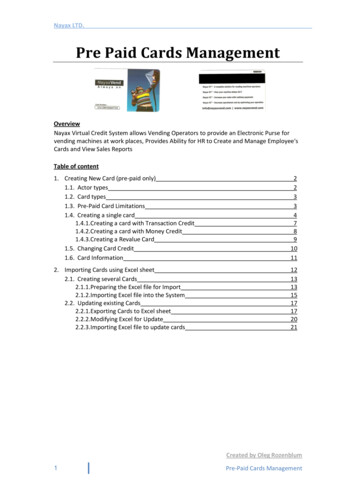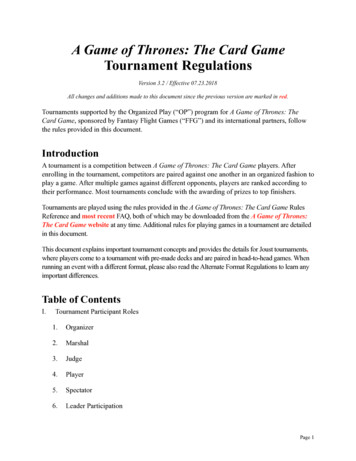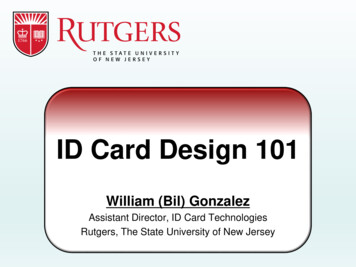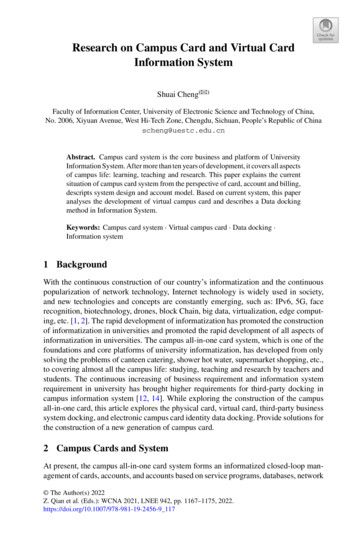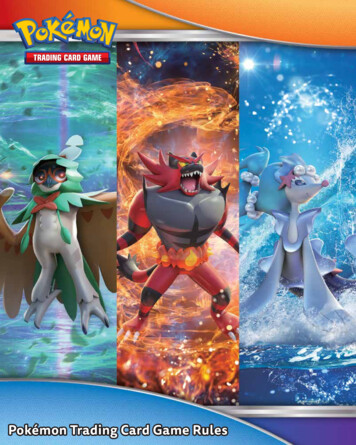
Transcription
Pokémon Trading Card Game RulesPokémon Trading Card Game Rules1
Pokémon Trading Card Game RulesContentsBecome a Pokémon Master! 3Pokémon TCG Basic Concepts 3How to Win 3Energy Types 4Parts of a Pokémon Card 53 Card Types 6Zones of the Pokémon TCG 7Playing the Game 8Winning the Game 8Setting Up to Play 8Parts of a Turn 9Turn Actions 10Special Conditions 15Pokémon Leagues and Trainer Kits 17Advanced Rules 18Full Details of Taking a Mulligan What Counts as an Attack? Full Details of Attacking What if You Should Draw More Cards than You Have? What if Both Players Win at the Same Time? What’s Sudden Death? What Does and Doesn’t Count for a Pokémon’s Name? 18192021212121Deck Building 22Appendix A: Pokémon-EX 23Special Rules for Pokémon-EX 23Appendix B: Mega Evolution Pokémon 24Special Rules for Mega Evolution Pokémon 24Appendix C: Restored Pokémon 25Key Restored Pokémon Notes 25Appendix D: ACE SPEC Trainer Cards Appendix E: Team Plasma Cards Appendix F: Team Flare Hyper Gear Appendix G: Ancient Traits Appendix H: BREAK Evolution 2626272728Special Rules for Pokémon BREAK 28Appendix I: Dual-Type Pokémon 28Appendix J: Pokémon-GX 29Special Rules for Pokémon-GX 29Appendix K: Alolan Pokémon 30Glossary 302
Pokémon Trading Card Game RulesYou are a Pokémon Trainer! You travel across the land, battling other Trainers with your Pokémon, creatures that love to battle and thathave amazing powers!BECOME A POKÉMON MASTER!These rules will tell you everything you need to play the Pokémon TradingCard Game. Your deck of cards represents your Pokémon as well as itemsand allies that help you on your adventures.Trading card games are strategy based and use collectible cards to leteach player customize their game. The best way to learn to play thePokémon TCG is with a Trainer Kit. This has two ready-to-play 30-carddecks that walk you through the game, step by step. From there, try atheme deck to get an idea of the different kinds of decks out there.You can also try Battle Arena Decks, which offer two ready-to-play 60-carddecks designed to go head to head for an intense battle!Once you’re ready, you can start building your collection of cards withPokémon TCG booster packs. Trade with your friends for the strongestPokémon, or collect all your favorites! Then, build your own 60-card deck,play with your friends, and show off your own personal Pokémon team!POKÉMON TCGBASIC CONCEPTSHOW TO WINIn the Pokémon TCG, your Pokémon battle your opponent’s Pokémon.The first player to take all of their Prize cards wins! Also, if your opponenthas no Pokémon left in play, or no cards left to draw at the beginning oftheir turn, you win the game!3
Pokémon Trading Card Game RulesENERGY TYPESPokémon Knock Out opposing Pokémon by using attacks or Abilities. To power their attacks, Pokémon need Energy cards.The Pokémon TCG has 11 Energy types, and you will find Pokémon matching all 11 types in the game.Each Energy type powers different attacks. Find the ones that match your personality! The Energy types are the following:GRASSGrass-type Pokémon oftenhave attacks that healthemselves or leave theiropponents Poisoned.LIGHTNINGLightning-type Pokémoncan bring back used Energyfrom the discard pile—andthey can leave theiropponents Paralyzed.DARKNESSDarkness-type Pokémonfeature sneaky attacks thatoften make opponentsdiscard cards!DRAGONDragon-type Pokémon havevery strong attacks, but oftenrequire two Energy types touse them.FIREFire-type Pokémon have bigattacks! They can leave theiropponents Burned, but theirattacks need time to buildup again.PSYCHICPsychic-type Pokémon aregreat for special powers!Their opponents often findthemselves Asleep, Confused,or Poisoned.METALMetal-type Pokémon canresist attacks for longer thanmost other Pokémon.WATERWater-type Pokémon canmanipulate Energy and movePokémon around on theother team.FIGHTINGFighting-type Pokémon cantake bigger risks to do extradamage, and some can flipcoins for combination hits.F er Special Conditions. An unfortunate Pokémon could be Burned, Paralyzed, andPoisoned all at the same time!16
POKÉMON LEAGUES AND TRAINER KITSThis is all you need to know toplay the game! If you need morehelp, ask your local store for aTrainer Kit. This kit shows youand a friend how to play an entiregame, start to finish!Learn to play Pokémon games!Earn cool prizes!Battle against other players!Ask your hobby store if they have a Pokémon League, or findone near you at www.pokemon.com/locator.Learn more at www.pokemon.com17
Pokémon Trading Card Game RulesADVANCED RULESFULL DETAILS OF TAKING A MULLIGANIf either player has no Basic Pokémon in their opening hand, that player must take a mulligan. Here’s how the timing works:If both players have no Basic Pokémon in their opening hands:Both players reveal their hands, then just start over as normal.If only one player has no Basic Pokémon in their opening hand:1That player announces that they have a mulligan, then waits until the other player has finished setting up to play.2 Then, the player with no Basic Pokémon reveals their hand and shuffles it back into their deck. The player keeps doing this untilthey get an opening hand with a Basic Pokémon, then proceeds as normal.3 Then, the player who did not have to start over may draw a card for each extra mulligan their opponent took. For example,if both players took 2 mulligans, and then Player A took 3 additional mulligans, Player B may draw up to 3 cards. If any of thosecards are Basic Pokémon, they may be put onto the Bench.4 Then, reveal all Active and Benched Pokémon, and begin the game.18
Pokémon Trading Card Game RulesWHAT COUNTS AS AN ATTACK?Every attack has a cost and a name, and it might have a base damage and damage text. Most of the text on a Pokémon describes its attack,even if it doesn’t do any damage.For example, Corsola’s Call for Family attack does no damage, but it’s still an attack! Anything else is called an Ability or something else.For instance, Oranguru’s Instruct Ability might let you draw cards, but it doesn’t count as an attack.Inkay’s Ink Spit attack affects Call for Family, but not Instruct.19
Pokémon Trading Card Game RulesFULL DETAILS OF ATTACKINGFor most attacks, the order in which you do things doesn’t really matter. However, for a complicated attack, here are the full steps:ALook at your Pokémon and decide which attack to use. Make sure you have the correct Energy attached. Then, announce youare using that attack.BBIf your Active Pokémon is Confused, check now to see if its attack fails.CMake any choices the attack requires you to make. For example, if an attack says, “Choose 1 of your opponent’s BenchedPokémon,” you would make that choice now.DDo anything the attack requires you to do to use it. For example, you must flip a coin if an attack says “Flip a coin. If tails, thisattack does nothing.”EApply any effects that might alter or cancel the attack. For example, if an attack that was used against your Pokémon last turnsays, “If the Defending Pokémon tries to attack during your opponent’s next turn, your opponent flips a coin. If tails, that attackdoes nothing.” (But remember—if an Active Pokémon moves to the Bench, all effects of attacks go away. So if your ActivePokémon has changed since your opponent used the attack in this example, you don’t have to flip a coin.)FApply any effects that happen before damage, then place damage counters, and then do all other effects.Figuring out how many damage counters to place is usually straightforward. However, if many things are changing the damage, followthese steps in this order:1Start with the base damage printed to the right of the attack. If an , –, or is printed next to it, the attack text will tell you howmuch damage to do. If an attack tells you to put damage counters on a Pokémon, you have no more calculations to do becausedamage counters aren’t affected by Weakness, Resistance, or any other effects on a Pokémon. Just put those damage counterson the affected Pokémon!2Figure out damage effects on your Active Pokémon based on Trainer cards or any other relevant effects. For example, if yourPokémon used an attack last turn that said, “During your next turn, this Pokémon’s attacks do 40 more damage (before applyingWeakness and Resistance),” then add that in. Stop if the base damage is 0 (or if the attack does not do any damage at all).Otherwise, keep going.3Increase the damage by the amount next to your opponent’s Active Pokémon’s Weakness, if it has Weakness to your ActivePokémon’s type.4 Reduce the damage by the amount next to your opponent’s Active Pokémon’s Resistance, if ithas Resistance to your Active Pokémon’s type.5Figure out damage effects of Trainer or Energy cards, or other effects on your opponent’sActive Pokémon. For example, if your opponent’s Active Pokémon has an Ability that says“This Pokémon takes 20 less damage from attacks (after applying Weakness and Resistance).”6 For each 10 damage of the final attack, put 1 damage counter on the affected Pokémon. If thedamage is 0 or less, don’t put on any damage counters!20
Pokémon Trading Card Game RulesWHAT IF YOU SHOULD DRAW MORE CARDS THAN YOU HAVE?If a card tells you to draw or look at more cards from your deck than you have left, draw or look at the cards you have and continue playas normal.For example, if a card tells you to draw or look at the top 5 cards of your deck and you have only 3 cards left in your deck, draw or look atthose 3. You lose if you cannot draw a card at the beginnin
Pokémon Trading Card Game Rules PLAYING THE GAME Pokémon TCG games are fast and furious. Here's the summary to play right away! HOW TO WIN THE GAME You can win the game in 3 ways: Take all of your Prize cards. Knock Out all of your opponent's in-play Pokémon. If your opponent has no cards in their deck at the beginning of their turn.

